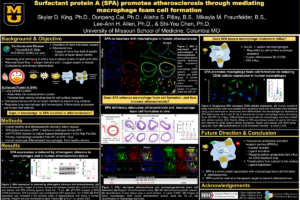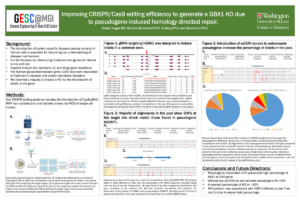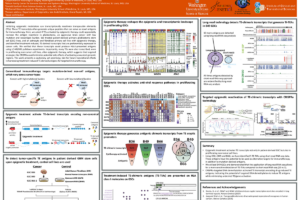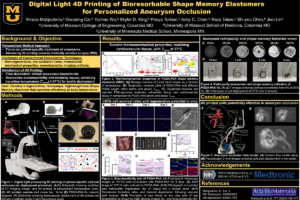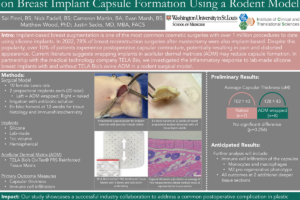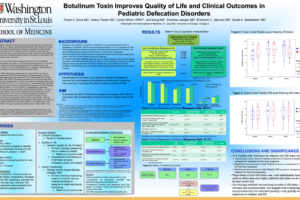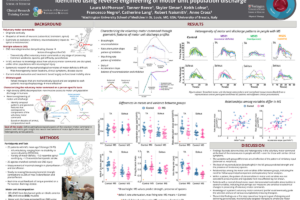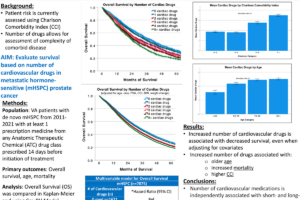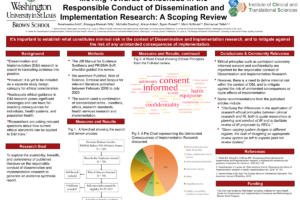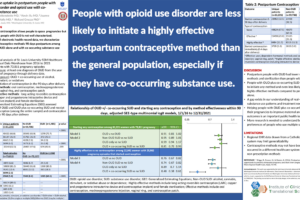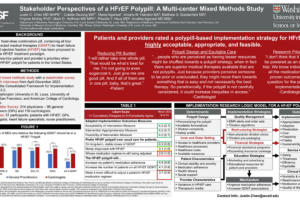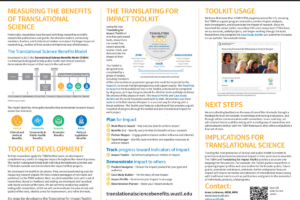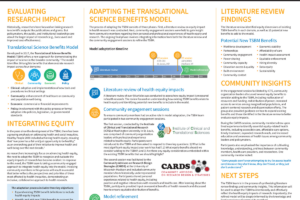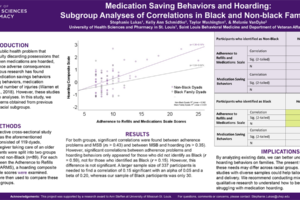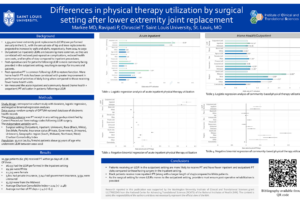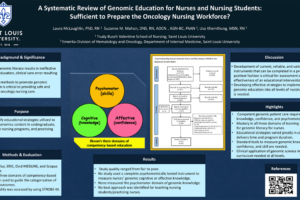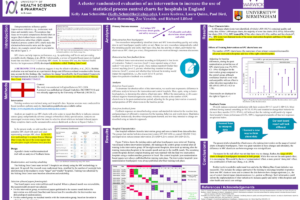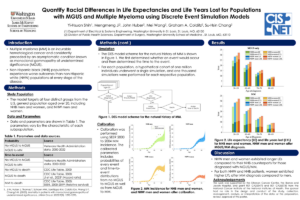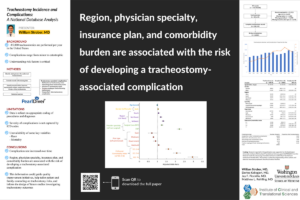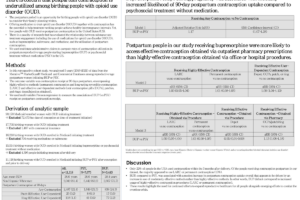2024 ICTS Symposium Posters
1. Surfactant Protein A Promotes Atherosclerosis through Mediating Macrophage Foam Cell Formation
Introduction: Atherosclerosis (AT) is a progressive cardiovascular disease characterized by persistent inflammation and excessive cholesterol deposition within the artery wall and is the fundamental pathological process underlying coronary artery disease and stroke. Macrophage (MФ) foam cells play a central role in the pathogenesis of AT. Surfactant protein A (SPA) is a lipid-associating protein involved with […]
2. Improving CRISPR/Cas9 Editing Efficiency to Generate a GBA1 KO due to Pseudogene-induced Homology Directed Repair
Introduction: The capability to translate research to the clinic is contingent upon the ability to study disease-causing mutations from patients in a cell type specific manner. This is most commonly accomplished through the introduction of these disease-causing mutations in induced pluripotent stem cells (iPSCs) and their subsequent differentiation. However, in certain cases, editing these genes […]
3. Epigenetic Therapy Activates TE-chimeric Transcripts to Provide an Additional Source of Glioblastoma HLA-I Antigens
Introduction: Inhibiting epigenetic modulators can transcriptionally reactivate transposable elements (TEs). These TE transcripts often generate unique peptides that can serve as novel antigens for immunotherapy. Here, we asked if TEs activated by epigenetic therapy could appreciably increase the antigen repertoire in glioblastoma, an aggressive brain cancer with low mutation and neoantigen burden. Methods: We treated […]
4. Digital Light 4D Printing of Bioresorbable Shape Memory Elastomers for Personalized Aneurysm Occlusion
Introduction: Globally, aneurysms affect 2-5% and afflict millions in the U.S., presenting significant health threats due to their high rupture rate that can lead to death. Conventional aneurysm coil treatments grapple with problems such as adverse bodily reactions, biocompatibility issues, and a recurrence risk of about 20%, with complete occlusion failures in 10-15% of patients […]
5. Evaluating the Effect of an Ovine Acellular Dermal Matrix on Breast Implant Capsule Formation Using a Rodent Model
Introduction: Implant-based breast augmentation is one of the most common cosmetic surgeries with over one million procedures performed to date using silicone implants. In 2022, 78% of breast reconstruction surgeries after mastectomy were also implant-based. Despite this popularity, over 10% of patients experience postoperative capsular contracture, potentially resulting in pain and distorted appearance. Current literature […]
6. Next Generation of Tissue Adhesive for Obliteration of Surgical Dead Space
Introduction: Many surgical procedures create large dead spaces prone to fluid accumulation, leading to hematomas and seromas. Drains are used to prevent these complications, but they often cause patient discomfort and have potential for infection. Our objective is to develop a biodegradable tissue adhesive with strong adhesion and biocompatibility to obliterate surgical dead space. Methods: […]
7. Botulinum Toxin Improves Quality of Life and Clinical Outcomes in Pediatric Defecation Disorders
Introduction: While internal anal sphincter (IAS) Botox has been increasingly utilized in children with disordered defecation (DD), no literature regarding clinical efficacy or quality of life (QoL) influence exists. Therefore, we aimed to elucidate the effect of IAS Botox as an adjunct to standard treatment for DD on patient/caregiver QoL metrics in association with corresponding […]
8. COVID-19 Vaccination Rates and Hesitancy Among Postpartum Individuals with Substance Use Disorders
Introduction: Pregnant individuals with substance use disorders (SUD) are at higher risk of developing severe complications from COVID-19. Infants < 6 months are also at significant risk. Vaccination in perinatal individuals can help protect both mother and infant from severe outcomes; however, vaccine hesitancy is high. We evaluated COVID-19 vaccination rates among postpartum patients with […]
9. Pathophysiology of Voluntary Motor Commands in People with Multiple Sclerosis Identified Using Reverse Engineering of Motor Unit Population Discharge
Introduction: Multiple sclerosis (MS) causes central nervous system lesions that alter neural communication between the brain and the spinal motoneurons that activate muscles. These voluntary motor commands consist of three components that must be appropriately balanced for skilled motor control: excitation, inhibition, and neuromodulation. Disruption of this balance has harmful effects, evidenced by work in […]
10. Cardiovascular Medications and Overall Survival in Metastatic Hormone-sensitive Prostate Cancer
Introduction: Assessment of comorbid cardiovascular disease can predict health outcomes and may risk-stratify patients for adverse events and death. Current methods used to estimate patient risk, such as the Charlson Comorbidity Index (CCI), are based on International Classification of Diseases (ICD) codes, which are a poor indicator of severity and complexity of comorbid disease. In […]
11. Optimizing the Work of Learning for Burnout Prevention: A Randomized Pilot Study of an Online CBT-based Intervention in Medical Students
Introduction: Burnout in medical trainees significantly increases their risk of suicidal ideation, and trainees are often reluctant to seek mental health care. Digital mindfulness and cognitive behavioral therapy (CBT) principles are evidence-based preventative strategies for reducing burnout and increasing professional satisfaction. We are conducting a randomized pilot study to assess whether digital interventions for CBT-based […]
12. Moving Towards Consensus in the Responsible Conduct of Dissemination and Implementation Research: A Scoping Review
Introduction: Dissemination and implementation (D&I) research, crucial in translating evidence into practice, is yet to be included as a separate study design category for ethical consideration. Researchers are asking relevant questions about how current ethical standards can be applied to D&I trials. The responsible conduct of D&I research requires an adaptation of existing bioethical frameworks […]
13. Contraceptive Uptake in Postpartum People with Opioid Use Disorder and Opioid Use with Co-Occurring Substance Use
Introduction: Delaying pregnancy allows people with opioid use disorder (OUD) to choose when they are ready to continue their families. We aim to address the lack of characterization of postpartum contraceptive uptake among people with OUD compared to people without OUD. Methods: Analyses used 73,811 pregnancy episodes among 61,221 people (2016-2021) from the St. Louis […]
14. Stakeholder Perspectives of a HFrEF Polypill: A Multi-center Mixed Methods Study
Introduction: A polypill containing all four classes of guideline-directed medical therapy (GDMT) for heart failure with reduced ejection (HFrEF) has been proposed to change the heart failure treatment paradigm. The acceptability, appropriateness, and feasibility of a HFrEF polypill-based strategy is unknown. The purpose of this study was to elicit patients’ and providers’ priorities in the […]
15. Prediction of In-hospital Mortality Using Artificial Intelligence to Handle Incomplete and Time-varying Intensive Care Unit Data
Introduction: Accurate prediction of Intensive Care Unit (ICU) patients’ mortality is crucial for healthcare professionals to make informed decisions, ultimately improving patient outcomes. However, ICU data are collected irregularly at different time points; therefore, these data are oftentimes incomplete and heterogeneous, hindering the performance of model-based statistical methods. This study aimed to use artificial intelligence […]
16. Translating for Impact: A Free Online Toolkit for Demonstrating the Larger Impact of Your Work
Introduction: In an increasingly competitive budgetary environment, we must be able to demonstrate the health and societal benefits of clinical and translational research. The Translational Science Benefits Model (TSBM) is a framework for evaluating the downstream health and social impact of research. The TSBM team created the online Translating for Impact Toolkit to help researchers […]
17. Translating for Equity Impact: A Community-engaged Approach to Integrate Health Equity into the Translational Science Benefits Model
Introduction: There have been increased efforts to recognize the effects, or lack thereof, of scientific research on health equity. The Translational Science Benefits Model (TSBM) is a framework for evaluating the impact of research on health and society. The TSBM team is currently integrating equity into the TSBM framework. Methods: Adaptation of the TSBM involved […]
18. Medication Saving Behaviors and Hoarding: Subgroup Analyses of Correlations in Black and Non-black Families
Introduction: Medication hoarding describes a persistent difficulty of discarding or parting with medications that are no longer useful. This behavior can result in mis-dosing and inappropriate sharing, leading to adverse consequences (Sorenson, 2005). Previous research has found correlations between medication savings behavior, hoarding, and medication adherence (Warren et al., 2019; VanDyke et al., 2018), but […]
19. Differences in Physical Therapy Utilization by Surgical Setting after Lower Extremity Joint Replacement
Introduction: Patients receiving a lower extremity joint replacement (LEJR) are commonly prescribed physical therapy (PT) to address pain, range of motion, and function. As LEJRs are more commonly performed in an outpatient setting, particularly in a younger population, patients are less likely to receive inpatient PT, potentially resulting in increased utilization of community-based (home health […]
20. A Systematic Review of Genomic Education for Nurses and Nursing Students: Sufficient to Prepare the Oncology Nursing Workforce?
Introduction: The completion of the Human Genome Project in 2003, a monumental scientific achievement that provided the first sequence of the human genome, marked a significant milestone in healthcare. This project laid the foundation for precision medicine, a healthcare approach that considers an individual’s genetic makeup and lifestyle factors in their treatment plans. As precision […]
21. A Cluster-Randomized Evaluation of an Intervention to Increase the Use of Statistical Process Control Charts for Hospitals in England
Introduction: Conversations between hospital board members, middle managers, and frontline staff often revolve around performance metrics, e.g., wait times and hospital-acquired infection rates. Where presentations focus on two-point comparisons (before/after) or targets (e.g., visualized with Red-Amber-Green (RAG) codes), initiatives could chase statistical noise rather than sound statistical signals of poor or superior performance. Statistical process […]
22. Quantify Racial Differences in Life Expectancies and Life Years Lost for Populations with MGUS and Multiple Myeloma using Discrete Event Simulation Models
Introduction: Multiple myeloma (MM) is an incurable hematological cancer, preceded by an asymptomatic pre-malignant condition – monoclonal gammopathy of undetermined significance (MGUS). Racial disparities have been demonstrated in every stage of MM, with non-Hispanic black (NHB) populations experiencing worse outcomes compared to their non-Hispanic white (NHW) counterparts. To understand and quantify racial disparities, we constructed […]
23. Tracheostomy Incidence and Complications: A National Database Analysis
Introduction: Tracheostomy is a common procedure that is associated with various complications ranging from minor hemorrhages to catastrophic events. An estimated 85,000 tracheostomies were performed per year between 2002-2017 in the United States, but despite the high frequency of tracheostomy procedures, the last study to investigate risk factors associated with tracheostomy complications was performed on […]
24. Postpartum Contraception Use Among People with Opioid Use Disorder: A Multi-state Analysis of Administrative Data in the United States
Introduction: Offering medication to treat opioid use disorder (MOUD) together with contraception has the potential to help treatment-seeking people achieve healthy interpregnancy intervals. We used multistate administrative claims to compute rates of contraception utilization in postpartum reproductive-age people starting buprenorphine (BUP) or psychosocial treatment without medication (PSY). Methods: In this retrospective cohort study, we analyzed […]
